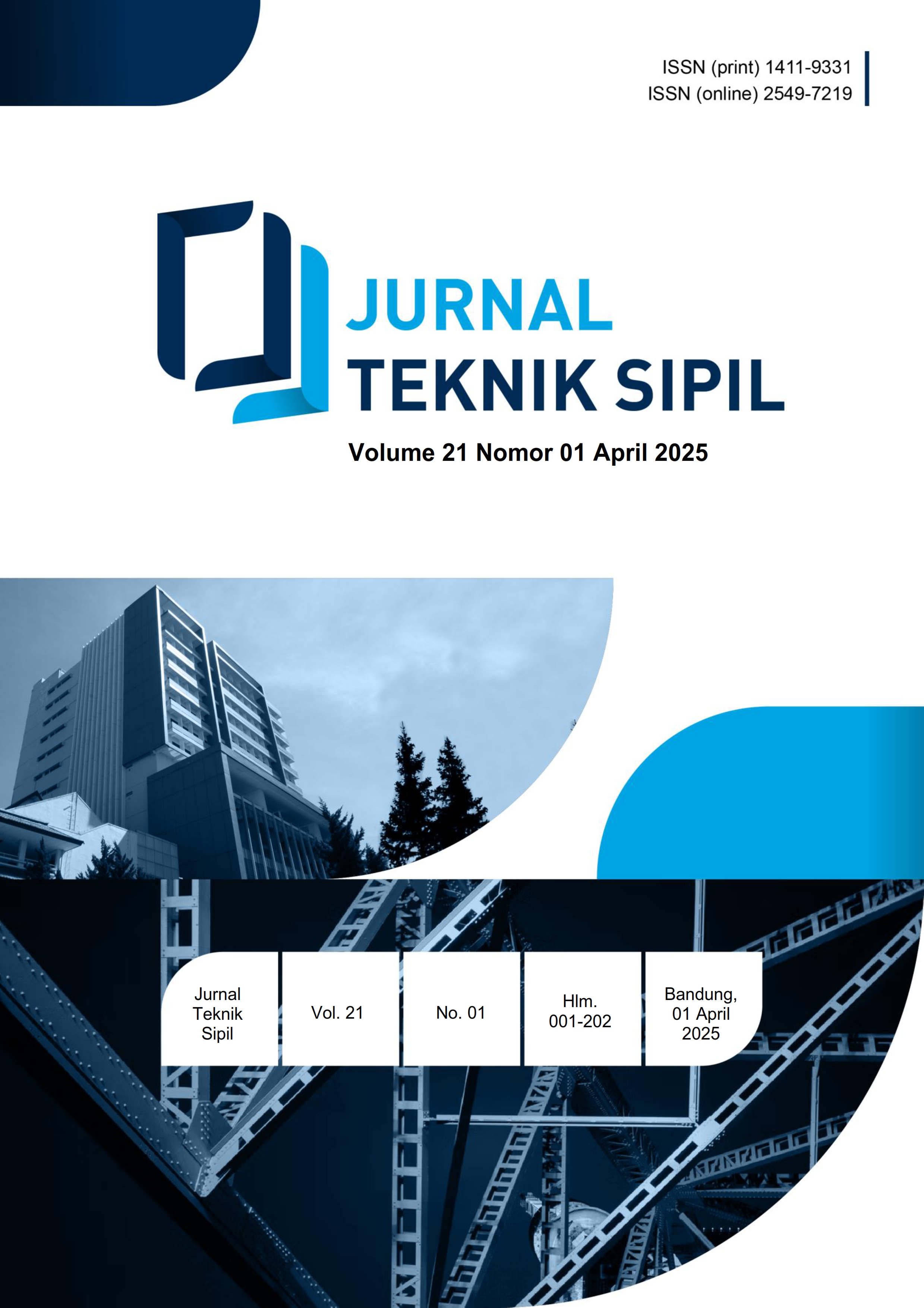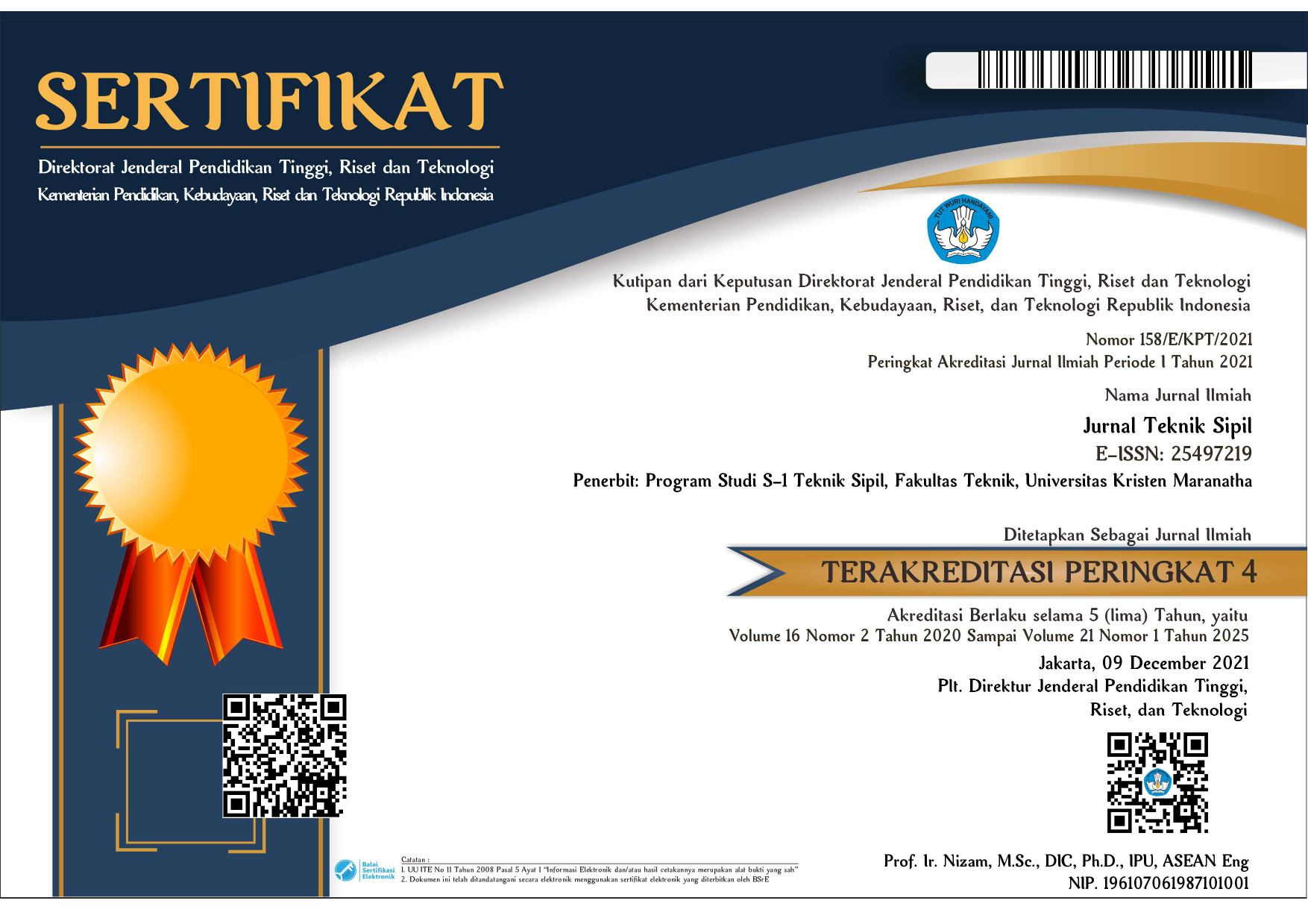Pengaruh Pencampuran Sodium Lignosulfonate (SLS) dan Abu Sekam Padi (RHA) untuk Stabilisasi Tanah Lempung
DOI:
https://doi.org/10.28932/jts.v21i1.7488Kata Kunci:
Abu Sekam Padi (RHA), Lempung, Konsolidasi, Kuat Geser Langsung, Sodium Lignosulfonate (SLS)Abstrak
Tanah lempung memiliki daya dukung yang relatif rendah dan kompresibilitas tinggi. Oleh karena itu, perlu dilakukan perbaikan tanah sebelum konstruksi dimulai. Penelitian ini bertujuan menganalisis pengaruh penambahan sodium lignosulfonate (SLS) dan abu sekam padi (RHA) sebagai bahan stabilisasi tanah lempung yang ditinjau berdasarkan nilai parameter kuat geser tanah, koefisien pemampatan dan koefisien konsolidasi. Sampel tanah lempung dalam penelitian ini berasal dari kawasan proyek perumahan Keandra Lagoon yang berlokasi di Kecamatan Tengah Tani, Kabupaten Cirebon. Hasil penelitian menunjukkan tanah asli dengan penambahan 10% abu sekam padi (RHA) dan 10% sodium lignosulfonate (SLS) sudut geser dalam yang terbentuk pada sampel tersebut sebesar 26,009° dengan kohesi 0,0635 kg/cm³. Nilai indeks pemampatan (Cc) terendah sebesar 0,125 diperoleh pada kadar 10% sodium lignosulfonate dan 10% abu sekam padi dengan perlakuan pemeraman selama 28 hari. Sedangkan nilai Koefisien konsolidasi (Cv) tertinggi sebesar 0,308 cm²/menit dihasilkan oleh tanah dengan campuran 10% sodium lignosulfonate dan 10% abu sekam padi dengan perlakukan pemeraman selama 0 hari. Sodium lignosulfonate (SLS) dan abu sekam padi (RHA) dapat menurunkan potensi kembang susut tanah berdasarkan pengujian konsolidasi.Unduhan
Referensi
Abdurrozak, Muhammad Rifqi. "Stabilisasi tanah lempung dengan bahan tambah abu sekam padi dan kapur pada subgrade perkerasan jalan." Teknisia (2017): 416-424.
Alazigha, D. P. et al. (2016),“The swelling behaviour of lignosulfonate-treated expansive soil,” Proceedings of the Institution of Civil Engineers: Ground Improvement, 169(3), hal. 182–193. doi: 10.1680/jgrim.15.00002.
Anwar Hossain, Khandaker M. (2011), "Stabilized soils incorporating combinations of rice husk ash and cement kiln dust." Journal of Materials in Civil Engineering 23.9:1320-1327
Badan Standarisasi Nasional. 1994. Cara Uji Berat Isi Tanah. SNI 03:3637:1994. Jakarta: Badan Standarisasi Nasional.
Badan Standarisasi Nasional. 2008. Cara Uji Berat Jenis Tanah. SNI 1964:2008. Jakarta: Badan Standarisasi Nasional.
Badan Standarisasi Nasional. 2008. Cara Uji Kadar Air untuk Tanah dan Batuan di Laboratorium. SNI 1965:2008. Jakarta: Badan Standarisasi Nasional.
Badan Standarisasi Nasional. 2008. Cara Uji Penentuan Batas Plastis dan Indeks Plastisitas Tanah. SNI 1966:2008. Jakarta: Badan Standarisasi Nasional.
Badan Standarisasi Nasional. 2008. Cara Uji Penentuan Batas Cair Tanah. SNI 1967:2008. Jakarta: Badan Standarisasi Nasional.
Badan Standarisasi Nasional. 2008. Cara Uji Penentuan Batas Susut Tanah. SNI 3422:2008. Jakarta: Badan Standarisasi Nasional.
Badan Standarisasi Nasional. 2011. Cara Uji Konsolidasi pada Tanah Satu Dimensi. SNI 2812:2011. Jakarta: Badan Standarisasi Nasional.
Badan Standarisasi Nasional. 2016. Cara Uji Kuat Geser Langsung Tidak Terkonsolidasi dan Tidak Terdrainase. SNI 3420:2016. Jakarta: Badan Standarisasi Nasional.
Bowles J.E. 1986. Sifat-sifat Fisis Tanah dan Geoteknis Tanah. Jakarta: Penerbit Erlangga.
Bradford, J. M. (1976) Fundamentals of Soil Behavior, Soil Science Society of America Journal. doi: 10.2136/sssaj1976.03615995004000040003x.
Canakci, H., Aziz, A. dan Celik, F. (2015) “Soil stabilization of clay with lignin, rice husk powder and ash,” Geomechanics and Engineering, 8(1), hal. 67–79. doi: 10.12989/gae.2015.8.1.067.
Chen, Q. dan Indraratna, B. (2015) “Deformation Behavior of Lignosulfonate-Treated Sandy Silt under Cyclic Loading,” Journal of Geotechnical and Geoenvironmental Engineering, 141(1), hal. 1–5. doi: 10.1061/(asce)gt.1943-5606.0001210.
Darwis, H. (2017) Dasar-Dasar Teknik Perbaikan Tanah. Yogyakarta : Pustaka
AQ Nyutran MG II
Depatemen Pekerjaan Umum (2007) “Perencanaan Stabilisasi Tanah dengan Serbuk Pengikat untuk Konstruksi Jalan,” (008).
Goma, J. M. dan Mwale, M. C. (2016) “Zambia’s Experience on the USE and Performance of Sulfonated Petroleum Products and Other Non-Conventional Soil Stabilizers in Road Construction,” hal. 164–171. doi: 10.1061/9780784480090.021.
Hardiyatmo, H. C. 1992. Mekanika Tanah I. Jakarta : PT. Gramedia Pustaka Utama
Hardjowigeno, Sarwono. (1989). Ilmu Tanah. Jakarta : Mediyatama Sarana Perkasa
Improvement, G., Gsp, G. dan Engineering, T. (2014) “Ground Improvement and Geosynthetics GSP 238 © ASCE 2014 158,” Geo-Shanghai 2014: Ground Improvement and Geosynthetics, (1987), hal. 158–167.
Indraratna, B. (2012) “Chemical minerological behaviour of lignousulfonate treated soil.,” GeoCongress 2012, (1999), hal. 3199–3208.
Karatai, Thomas Rukenya, et al. "Soil stabilization using rice husk ash and natural lime as an alternative to cutting and filling in road construction." Journal of Construction Engineering and Management 143.5 (2017): 04016127.
Kim, S., Gopalakrishnan, K. dan Ceylan, H. (2012) “Moisture susceptibility of subgrade soils stabilized by lignin-based renewable energy coproduct,” Journal of Transportation Engineering, 138(11), hal. 1283–1290. doi: 10.1061/(ASCE)TE.1943-5436.0000097.
Li, Y. (2019) “Laboratory and in situ evaluations of using bio-based co-product for pavement geo-materials stabilization.”
Manoppo, C, J., Manoppo, F, J. dan Rondonuwu, S, G. (2017) “Analisis Perkuatan Tanah Dengan Metode Sand Compaction Pile Pada Tanah Rawa (Studi Kasus: Jalan Tol Manado Bitung Sulut),” Jurnal Sipil Statik, 5(6), hal. 357–362.Tersedia pada: https://ejournal.unsrat.ac.id/index.php/jss/article /view/16753.
Mulyono, Tri (2017). "Klasifikasi Tanah Modul 5: Mekanika Tanah dan Pondasi"(PDF). Jakarta: Program Studi D3 Teknik Sipil Fakultas Teknik Universitas Negeri Jakarta
Mustafayeva, Arailym, et al. (2023). "Mechanical Properties and Microscopic Mechanism of Basic Oxygen Furnace (BOF) Slag-Treated Clay Subgrades." Buildings 13.12 : 2962.
Ocheme, J. I., Olagunju, S. O., Khamitov, R., Satyanaga, A., Kim, J., & Moon, S. W. (2023). Triaxial shear behavior of calcium sulfoaluminate (CSA)-treated sand under high confining pressures. Geomechanics and Engineering, 33(1), 41-51.
Olagunju, Sakiru Olarewaju, et al. (2023). "Physical, mechanical, chemical, and environmental characterization of stockpiled BOF slag as railway ballast material." Construction and Building Materials 408 : 133613.
Pavements, H. (2019) “Airfield and Highway Pavements 2019 255,” 3(Monteiro 2009), hal. 255–265.
Saleh, Abdul Rachman, and Fuad Harwadi. "Stabilisasi Tanah Lempung Lunak dengan Abu Sekam Padi (RHA) dan Kapur (CaCO3) di Kampung Satu Kota Tarakan." Jurnal Teknik UBT 1.1 (2017): 1-6.
Xiaochao, T. dan Nordfors, I. (2020) “Geo-Congress 2020 GSP 315 582,” Geo-Congress 2020 GSP, (2016), hal. 582–591.
Zhang, T., Cai, G. dan Liu, S. (2018) “Application of Lignin-Stabilized Silty Soil in Highway Subgrade: A Macroscale Laboratory Study,” Journal of Materials in Civil Engineering, 30(4), hal. 1–16. doi: 10.1061/(asce)mt.1943-5533.0002203.
Zhang, T., Cai, G. dan Liu, S. (2018) “Reclaimed Lignin-Stabilized Silty Soil: Undrained Shear Strength, Atterberg Limits, and Microstructure Characteristics,” Journal of Materials in Civil Engineering, 30(11), hal. 1–9. doi: 10.1061/(asce)mt.1943-5533.0002492.
Zhang, X. et al. (2020) “Shakedown Behavior of Yellow River Alluvial Silt Stabilized with Lignin–Lime Combined Additive,” Journal of Materials in Civil Engineering, 32(1), hal. 1–10. doi: 10.1061/(asce)mt.1943-5533.0002954.
Zheng, C., Yang, Q. dan Huang, J. (2019) “Lignin with and without Polymerization for Soil Stabilization,” Journal of Materials in Civil Engineering, 31(12). doi: 10.1061/(asce)mt.1943-5533.0002935.
##submission.downloads##
Diterbitkan
Cara Mengutip
Terbitan
Bagian
Lisensi
Hak Cipta (c) 2024 Erlian Tamara, Sri Wulandari

Artikel ini berlisensi Creative Commons Attribution-NonCommercial 4.0 International License.
























